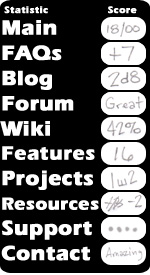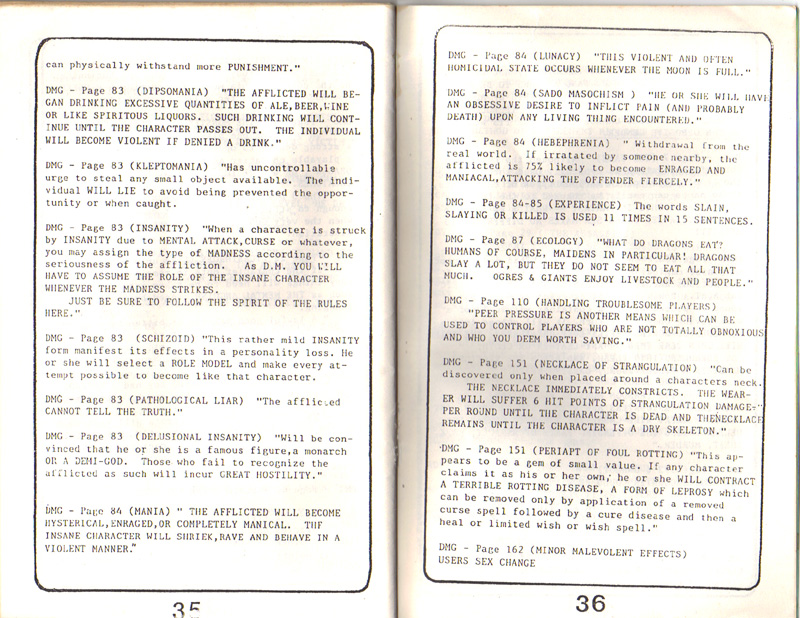
|

|
Main > Archives > As BADD As It Gets
(Click the left page to go back, or the right page to go forward) Page 35 The first edition Dungeon Master's Guide contained an extensive section on insanity, which could be used when a character suffered a curse or some manner of mental trauma or attack. Each type featured a short desciption of the kind of behavior that a character would exhibit. So a character with Dipsomania, for example, would overindulge in alcohol whenever the opportunity presented itself. These were not actions for the player to take, of course - but they could make for interesting story elements, such as a kleptomaniac character uncontrollably taking small items from a nobleman's home and getting into big, big trouble for it. They are listed here to add color to characters and stories - not to glorify, or even belittle real world mental disabilities. This same information appears, in much more accurate detail, in psychology textbooks everywhere.(Unfortunately, the DMG makes the same mistake that many others do about the nature of shizophrenia, which is not the same thing as split personality syndrome.) Page 36 DMG - Page 84-85 (EXPERIENCE) - The words slain, slaying or killed are used 15 times in 11 sentences - but what isn't mentioned here is that those sentences aren't consecutive. This section of the book deals with experience points, which are given as a reward to characters for slaying monsters, collecting treasure, and achieving adventure goals. So those three words are more common on page 84 than the rest of the book. It's interesting to note that the word "killed" is the third word on page 85, which is included here just to bump the count up by one (and those three words do not appear anywhere else on that page). DMG - Page 87 (ECOLOGY) - The concept of dragons, ogres, and giants having humans as a primary component of their diet comes to us from fairy tales. Dungeons & Dragons didn't invent it. I wonder how B.A.D.D. felt about Hansel & Gretel and Jack and the Beanstalk, or most of the Brothers Grimm. DMG - Page 110 (HANDLING TROUBLESOME PLAYERS) - This is a tip to keep some players from ruining the game for everyone. It's a tip that works with any group of people who are enjoyng a pastime - get the members of the group to help the offending player understand that he or she is ruining their fun. Sometimes, you'd rather keep a player in your game rather than turn them away. That's what the "saved" comment is referring to. (At page 120, the Dungeon Master's Guide begins to list various types of magic items.) DMG - Page 151 (NECKLACE OF STRANGULATION) - This was a cursed magic item. No real, living person was ever harmed by these words written on a page - but many a character was done in by putting one of these on after finding it in a treasure horde. (And when that happened, they rolled up a new character and kept playing, rather than pull a Black Leaf.) DMG - Page 151 (PERIDAPT OF FOUL ROTTING) - Again, a description of a cursed magic item, using words that have harmed no one. In this case, a character who has been affected by this item could find themselves on a quest to identify the source of their problem, and then seek a cure for it. DMG - Page 162 (MINOR MALEVOLENT EFFECTS) - "User's sex changes" is the actual text here. This was taken from a list of effects that a Dungeon Master could apply to an artifact - a super-powerful magic item (think of the One Ring from The Lord of the Rings). This effect changed the character's sex, nothing more and nothing less. In some games it presented a roleplaying challenge to play a character that was now of the opposite sex as before - in others it was a source of comedy.
|

